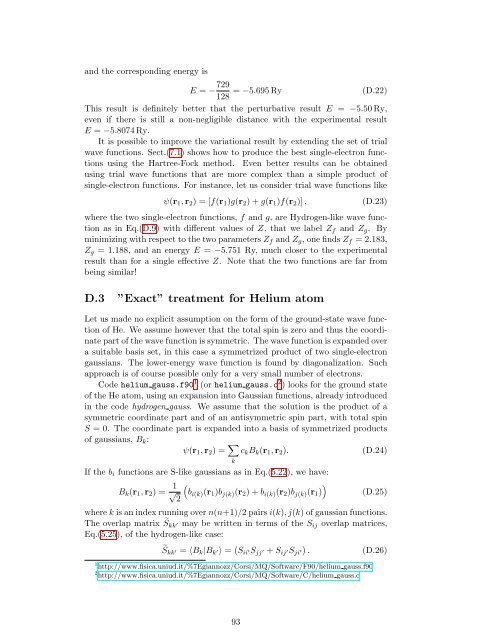Numerical Methods in Quantum Mechanics - Dipartimento di Fisica
Numerical Methods in Quantum Mechanics - Dipartimento di Fisica
Numerical Methods in Quantum Mechanics - Dipartimento di Fisica
You also want an ePaper? Increase the reach of your titles
YUMPU automatically turns print PDFs into web optimized ePapers that Google loves.
and the correspond<strong>in</strong>g energy is<br />
E = − 729 = −5.695 Ry (D.22)<br />
128<br />
This result is def<strong>in</strong>itely better that the perturbative result E = −5.50 Ry,<br />
even if there is still a non-negligible <strong>di</strong>stance with the experimental result<br />
E = −5.8074 Ry.<br />
It is possible to improve the variational result by extend<strong>in</strong>g the set of trial<br />
wave functions. Sect.(7.1) shows how to produce the best s<strong>in</strong>gle-electron functions<br />
us<strong>in</strong>g the Hartree-Fock method. Even better results can be obta<strong>in</strong>ed<br />
us<strong>in</strong>g trial wave functions that are more complex than a simple product of<br />
s<strong>in</strong>gle-electron functions. For <strong>in</strong>stance, let us consider trial wave functions like<br />
ψ(r 1 , r 2 ) = [f(r 1 )g(r 2 ) + g(r 1 )f(r 2 )] ,<br />
(D.23)<br />
where the two s<strong>in</strong>gle-electron functions, f and g, are Hydrogen-like wave function<br />
as <strong>in</strong> Eq.(D.9) with <strong>di</strong>fferent values of Z, that we label Z f and Z g . By<br />
m<strong>in</strong>imiz<strong>in</strong>g with respect to the two parameters Z f and Z g , one f<strong>in</strong>ds Z f = 2.183,<br />
Z g = 1.188, and an energy E = −5.751 Ry, much closer to the experimental<br />
result than for a s<strong>in</strong>gle effective Z. Note that the two functions are far from<br />
be<strong>in</strong>g similar!<br />
D.3 ”Exact” treatment for Helium atom<br />
Let us made no explicit assumption on the form of the ground-state wave function<br />
of He. We assume however that the total sp<strong>in</strong> is zero and thus the coord<strong>in</strong>ate<br />
part of the wave function is symmetric. The wave function is expanded over<br />
a suitable basis set, <strong>in</strong> this case a symmetrized product of two s<strong>in</strong>gle-electron<br />
gaussians. The lower-energy wave function is found by <strong>di</strong>agonalization. Such<br />
approach is of course possible only for a very small number of electrons.<br />
Code helium gauss.f90 1 (or helium gauss.c 2 ) looks for the ground state<br />
of the He atom, us<strong>in</strong>g an expansion <strong>in</strong>to Gaussian functions, already <strong>in</strong>troduced<br />
<strong>in</strong> the code hydrogen gauss. We assume that the solution is the product of a<br />
symmetric coord<strong>in</strong>ate part and of an antisymmetric sp<strong>in</strong> part, with total sp<strong>in</strong><br />
S = 0. The coord<strong>in</strong>ate part is expanded <strong>in</strong>to a basis of symmetrized products<br />
of gaussians, B k :<br />
ψ(r 1 , r 2 ) = ∑ c k B k (r 1 , r 2 ).<br />
(D.24)<br />
k<br />
If the b i functions are S-like gaussians as <strong>in</strong> Eq.(5.22), we have:<br />
B k (r 1 , r 2 ) = √ 1<br />
)<br />
(b i(k) (r 1 )b j(k) (r 2 ) + b i(k) (r 2 )b j(k) (r 1 )<br />
2<br />
(D.25)<br />
where k is an <strong>in</strong>dex runn<strong>in</strong>g over n(n+1)/2 pairs i(k), j(k) of gaussian functions.<br />
The overlap matrix ˜S kk ′ may be written <strong>in</strong> terms of the S ij overlap matrices,<br />
Eq.(5.25), of the hydrogen-like case:<br />
˜S kk ′ = 〈B k |B k ′〉 = ( S ii ′S jj ′ + S ij ′S ji ′) . (D.26)<br />
1 http://www.fisica.uniud.it/%7Egiannozz/Corsi/MQ/Software/F90/helium gauss.f90<br />
2 http://www.fisica.uniud.it/%7Egiannozz/Corsi/MQ/Software/C/helium gauss.c<br />
93
















